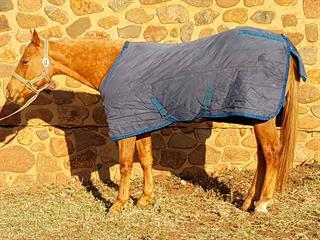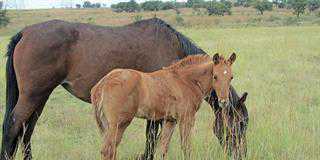
Keeping warm takes a great deal of energy and horses that are blanketed often keep their condition better in winter. Horse blankets include everything from the home-made variety worn by working horses in the highlands of Lesotho to stylish imported New Zealand rugs used on expensive jumpers.
You can buy them online, or at your local feed store or tack shop. There are essentially two types of horse blanket: day sheets and winter rugs.
Day sheets
Various kinds of day sheet are available. Some are made of unlined cotton and used to keep horses clean. The sweat sheet is useful for endurance and race horses, as well as jumpers, when they have been washed or are wet from sweat. Small holes in the material encourage evaporation, without the horse getting cold.
In winter, sweat sheets can be put on under a rug until the horse is dry, then removed. Fly sheets are made of lightweight, breathable polyester, and usually reflect light to prevent overheating. They cover the horse’s body and neck and prevent it from being bitten by midges and stable flies.
Winter rugs
Winter rugs always have linings and are mainly designed for warmth. New Zealand rugs are used for show horses that are not stabled in winter. They are made of tough waterproof material and have straps to keep the rug in place if the horse gallops and bucks. Some have attachable hoods, neck covers and tail flaps.
These rugs are not designed to be used in stables, although they are advisable in winter for clipped horses that are out in the paddock during the day.
Most SA horse owners will use affordable quilted or two-layered winter rugs. These are needed for warmth at night and on cold days, and will help to prevent the horse from losing condition.
Estimating size
Make sure you buy the correct size of sheet or rug, or it can slip and even cause injury. Some of the cheaper winter rugs are sold only in three sizes: ‘small’ (pony), ‘medium’ (cob, Arab and Boerperd) and ‘large’ (Thoroughbred and warmblood) sizes.
More expensive rugs are measured in centimetres from the middle of the horse’s chest, along its body, to the groove under the tail. For example, an 11,2-hand pony would need a 137cm blanket, while a 17,2-hand warmblood would need a 220cm blanket.
To put a rug on your horse, fold it in half with the outside layer inside, and lay it over the animal’s withers. Unfold the rug over the hindquarters, then do up the straps in front of the chest.
Adjust the rug by pulling it gently backwards, then do up the straps crosswise under the belly. Belly-straps must be adjusted so that there is about 10cm (a hand’s width) between the horse’s body and each strap. Next, lift the tail and do up the back straps.
If you are blanketing the horse for the first time, offer it treats or lucerne while you put the blanket on and pull it off a few times. Then fasten the straps and lead the horse around until it’s calm.
Dr Mac is a practising equine veterinarian and a stud owner.













